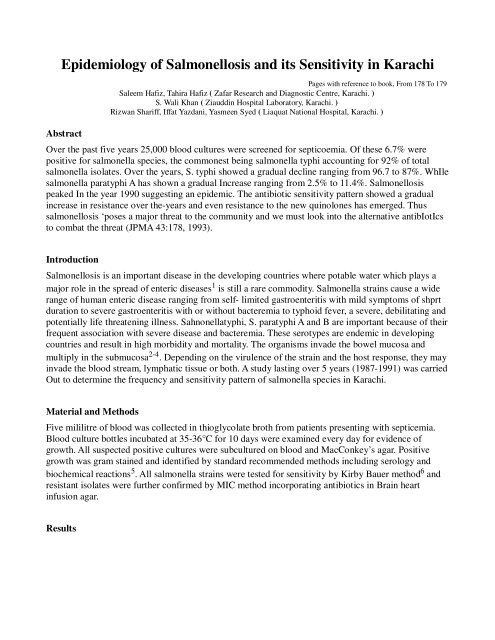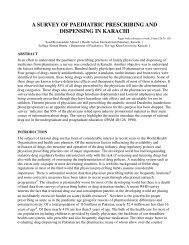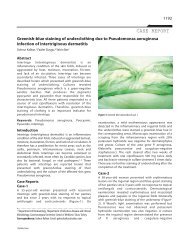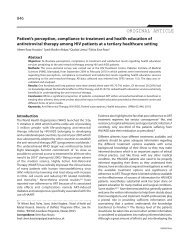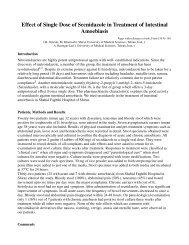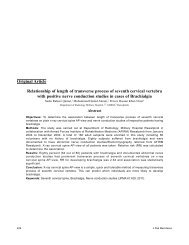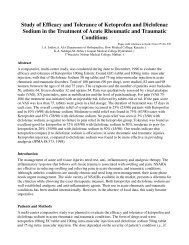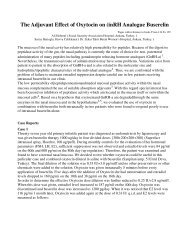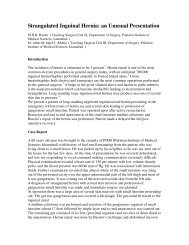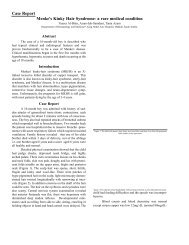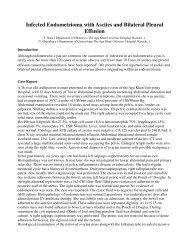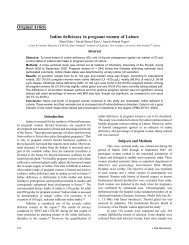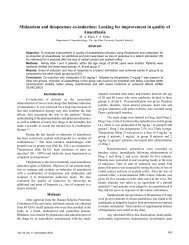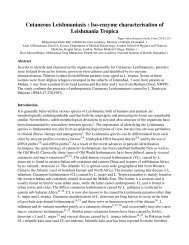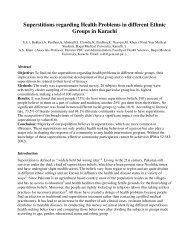Epidemiology of Salmonellosis and its Sensitivity in Karachi
Epidemiology of Salmonellosis and its Sensitivity in Karachi
Epidemiology of Salmonellosis and its Sensitivity in Karachi
You also want an ePaper? Increase the reach of your titles
YUMPU automatically turns print PDFs into web optimized ePapers that Google loves.
<strong>Epidemiology</strong> <strong>of</strong> <strong>Salmonellosis</strong> <strong>and</strong> <strong>its</strong> <strong>Sensitivity</strong> <strong>in</strong> <strong>Karachi</strong><br />
Abstract<br />
Pages with reference to book, From 178 To 179<br />
Saleem Hafiz, Tahira Hafiz ( Zafar Research <strong>and</strong> Diagnostic Centre, <strong>Karachi</strong>. )<br />
S. Wali Khan ( Ziaudd<strong>in</strong> Hospital Laboratory, <strong>Karachi</strong>. )<br />
Rizwan Shariff, Iffat Yazdani, Yasmeen Syed ( Liaquat National Hospital, <strong>Karachi</strong>. )<br />
Over the past five years 25,000 blood cultures were screened for septicoemia. Of these 6.7% were<br />
positive for salmonella species, the commonest be<strong>in</strong>g salmonella typhi account<strong>in</strong>g for 92% <strong>of</strong> total<br />
salmonella isolates. Over the years, S. typhi showed a gradual decl<strong>in</strong>e rang<strong>in</strong>g from 96.7 to 87%. WhIle<br />
salmonella paratyphi A has shown a gradual Increase rang<strong>in</strong>g from 2.5% to 11.4%. <strong>Salmonellosis</strong><br />
peaked In the year 1990 suggest<strong>in</strong>g an epidemic. The antibiotic sensitivity pattern showed a gradual<br />
<strong>in</strong>crease <strong>in</strong> resistance over the-years <strong>and</strong> even resistance to the new qu<strong>in</strong>olones has emerged. Thus<br />
salmonellosis ‘poses a major threat to the community <strong>and</strong> we must look <strong>in</strong>to the alternative antibIotIcs<br />
to combat the threat (JPMA 43:178, 1993).<br />
Introduction<br />
<strong>Salmonellosis</strong> is an important disease <strong>in</strong> the develop<strong>in</strong>g countries where potable water which plays a<br />
major role <strong>in</strong> the spread <strong>of</strong> enteric diseases 1 is still a rare commodity. Salmonella stra<strong>in</strong>s cause a wide<br />
range <strong>of</strong> human enteric disease rang<strong>in</strong>g from self- limited gastroenteritis with mild symptoms <strong>of</strong> shprt<br />
duration to severe gastroenteritis with or without bacteremia to typhoid fever, a severe, debilitat<strong>in</strong>g <strong>and</strong><br />
potentially life threaten<strong>in</strong>g illness. Sahnonellatyphi, S. paratyphi A <strong>and</strong> B are important because <strong>of</strong> their<br />
frequent association with severe disease <strong>and</strong> bacteremia. These serotypes are endemic <strong>in</strong> develop<strong>in</strong>g<br />
countries <strong>and</strong> result <strong>in</strong> high morbidity <strong>and</strong> mortality. The organisms <strong>in</strong>vade the bowel mucosa <strong>and</strong><br />
multiply <strong>in</strong> the submucosa 2-4 . Depend<strong>in</strong>g on the virulence <strong>of</strong> the stra<strong>in</strong> <strong>and</strong> the host response, they may<br />
<strong>in</strong>vade the blood stream, lymphatic tissue or both. A study last<strong>in</strong>g over 5 years (1987-1991) was carried<br />
Out to determ<strong>in</strong>e the frequency <strong>and</strong> sensitivity pattern <strong>of</strong> salmonella species <strong>in</strong> <strong>Karachi</strong>.<br />
Material <strong>and</strong> Methods<br />
Five mililitre <strong>of</strong> blood was collected <strong>in</strong> thioglycolate broth from patients present<strong>in</strong>g with septicemia.<br />
Blood culture bottles <strong>in</strong>cubated at 35-36°C for 10 days were exam<strong>in</strong>ed every day for evidence <strong>of</strong><br />
growth. All suspected positive cultures were subcultured on blood <strong>and</strong> MacConkey’s agar. Positive<br />
growth was gram sta<strong>in</strong>ed <strong>and</strong> identified by st<strong>and</strong>ard recommended methods <strong>in</strong>clud<strong>in</strong>g serology <strong>and</strong><br />
biochemical reactions 5 . All salmonella stra<strong>in</strong>s were tested for sensitivity by Kirby Bauer method 6 <strong>and</strong><br />
resistant isolates were further confirmed by MIC method <strong>in</strong>corporat<strong>in</strong>g antibiotics <strong>in</strong> Bra<strong>in</strong> heart<br />
<strong>in</strong>fusion agar.<br />
Results
Table I shows the frequency <strong>of</strong> salmonellosis <strong>in</strong> <strong>Karachi</strong> over five years. A rise <strong>in</strong> the frequency <strong>of</strong><br />
salnionellosis was seen <strong>in</strong> the year 1990 which is suggestive <strong>of</strong> an epidemic. An <strong>in</strong>crease <strong>of</strong> 50% was<br />
noted <strong>in</strong> blood culture due to salmonella.<br />
Table II gives the breakdown <strong>of</strong> species <strong>of</strong> salmonella responsible for bacteremia. Over the years there<br />
was a gradual <strong>in</strong>crease <strong>in</strong> the frequency <strong>of</strong> salmonella paratyphi A caus<strong>in</strong>g septicemia <strong>and</strong> <strong>in</strong> the year<br />
1991, 11.4% <strong>of</strong> septicemic cases were due to salmonella paratyphi A.<br />
Table III gives the sensitivity pattern <strong>of</strong> the isolates. Highest resistance was seen <strong>in</strong> the year 1990
<strong>in</strong>clud<strong>in</strong>g resistance to qu<strong>in</strong>olone group <strong>of</strong> antibiotics.<br />
Discussion<br />
<strong>Salmonellosis</strong> is one <strong>of</strong> the commonest cause <strong>of</strong> septicemia <strong>in</strong> the develop<strong>in</strong>g countries. It is endemic <strong>in</strong><br />
Pakistan <strong>and</strong> has a high morbidity <strong>and</strong> mortality. Dur<strong>in</strong>g the five years period <strong>of</strong> study the frequency<br />
ranged from 4.6% to 9.6% peak<strong>in</strong>g <strong>in</strong> 1990 which po<strong>in</strong>ts to a small epidemic. Although salmonella<br />
typhi accounts for more than 90% <strong>of</strong> salmonellic septicemia, the <strong>in</strong>cidence <strong>of</strong> salmonella paratyphi<br />
caus<strong>in</strong>g septicemia has shown a gradual <strong>in</strong>crease. The resistance <strong>of</strong> all salmonella species to the three<br />
antibiotics <strong>of</strong> choice, i.e., ampicill<strong>in</strong>, chloraxnphenicol <strong>and</strong> septran has also shown a gradual <strong>in</strong>crease.<br />
Multiple resistant salmonella <strong>in</strong>clud<strong>in</strong>g salmonella typhi were first seen <strong>in</strong> 1987 7 <strong>and</strong> s<strong>in</strong>ce then has<br />
been on <strong>in</strong>crease; more than 50% <strong>of</strong> the isolates have now become resistant to cotrimoxazole. The<br />
highest drug resistance among the salmonella isolates was seen <strong>in</strong> the year 1990 where 24 isolates<br />
which <strong>in</strong>cluded 20 <strong>of</strong> salmonella typhi, 3 salmonella paratyphi A <strong>and</strong> one salmonella paratyphi B were<br />
resistant to qu<strong>in</strong>olones (<strong>of</strong>loxac<strong>in</strong>) The overall resistance to qu<strong>in</strong>olones was 3.3%. The MIC <strong>of</strong> the<br />
isolates exceeded 64 uG/ml to <strong>of</strong>loxac<strong>in</strong>. In 1991 qu<strong>in</strong>olone resistance marg<strong>in</strong>ally decl<strong>in</strong>ed. The general<br />
<strong>in</strong>crease <strong>in</strong> resistance is very alarm<strong>in</strong>g because if the isolates show extensive resistance to the three<br />
drugs <strong>of</strong> choice then we would be limited <strong>in</strong> choice for ideal antibiotics. Qu<strong>in</strong>olones are not<br />
recommended <strong>in</strong> children, other alternatives <strong>in</strong>clude cephalospor<strong>in</strong>s <strong>and</strong> fosfomyc<strong>in</strong> which aga<strong>in</strong> are<br />
show<strong>in</strong>g <strong>in</strong>creas<strong>in</strong>g resistance; this leaves the possibility <strong>of</strong> attempt<strong>in</strong>g to use amoxicffl<strong>in</strong> culvanalic<br />
acid comb<strong>in</strong>ation which shows a high sensitivity.<br />
References<br />
1. Wolfe, S.M. Diseases <strong>of</strong> travellers. Cl<strong>in</strong>ical symposia; Medical Education Division. CIBA<br />
Pharmaceutical Company, New Jersey, 1984;36:2-3.<br />
2. Ashcr<strong>of</strong>t, M.T. Typhoid <strong>and</strong> paratyphoid fever <strong>in</strong> tropics. Medical Research Council,<br />
Epidemiological Research Unit, Unicersity <strong>of</strong> West Indies, K<strong>in</strong>gston, Augus 1964; 1-50.<br />
3. James, M.D. Salmonella <strong>in</strong>fection <strong>in</strong> the community. Public Health, 1985;99:79-84.<br />
4. Hornick, RB., Greisman, SE. <strong>and</strong> Woodward, T.E. 1\\jphoid fever; patbogenesis <strong>and</strong> immunologic<br />
controL N. Engl.Med., 1970;283:739-46.<br />
5. Farmer, J.J. <strong>and</strong> Kelly, M.T. Enterobacteriaceae manual <strong>of</strong> cl<strong>in</strong>ical microbiology; 5thedition.<br />
American Society for Microbiology Wash<strong>in</strong>gton, D.C. 1991;360-83.<br />
6. Bauer, A.W., Kirby, W.M.M., Sherrs, J.C. <strong>and</strong> Turck, M. Antibiotic susceptibility test<strong>in</strong>g by a<br />
st<strong>and</strong>ardized s<strong>in</strong>gle disk method. Am.J.Cl<strong>in</strong>.Pathol., 1966;45:493-96.<br />
7. Hafiz, S., Lyall, N., Punjwani, S. <strong>and</strong> Zaidi, SQ. Reliable <strong>and</strong> realistic approach to sensitivity test<strong>in</strong>g<br />
J.Pak.Med.Assoc., 1989;39:94-97.


